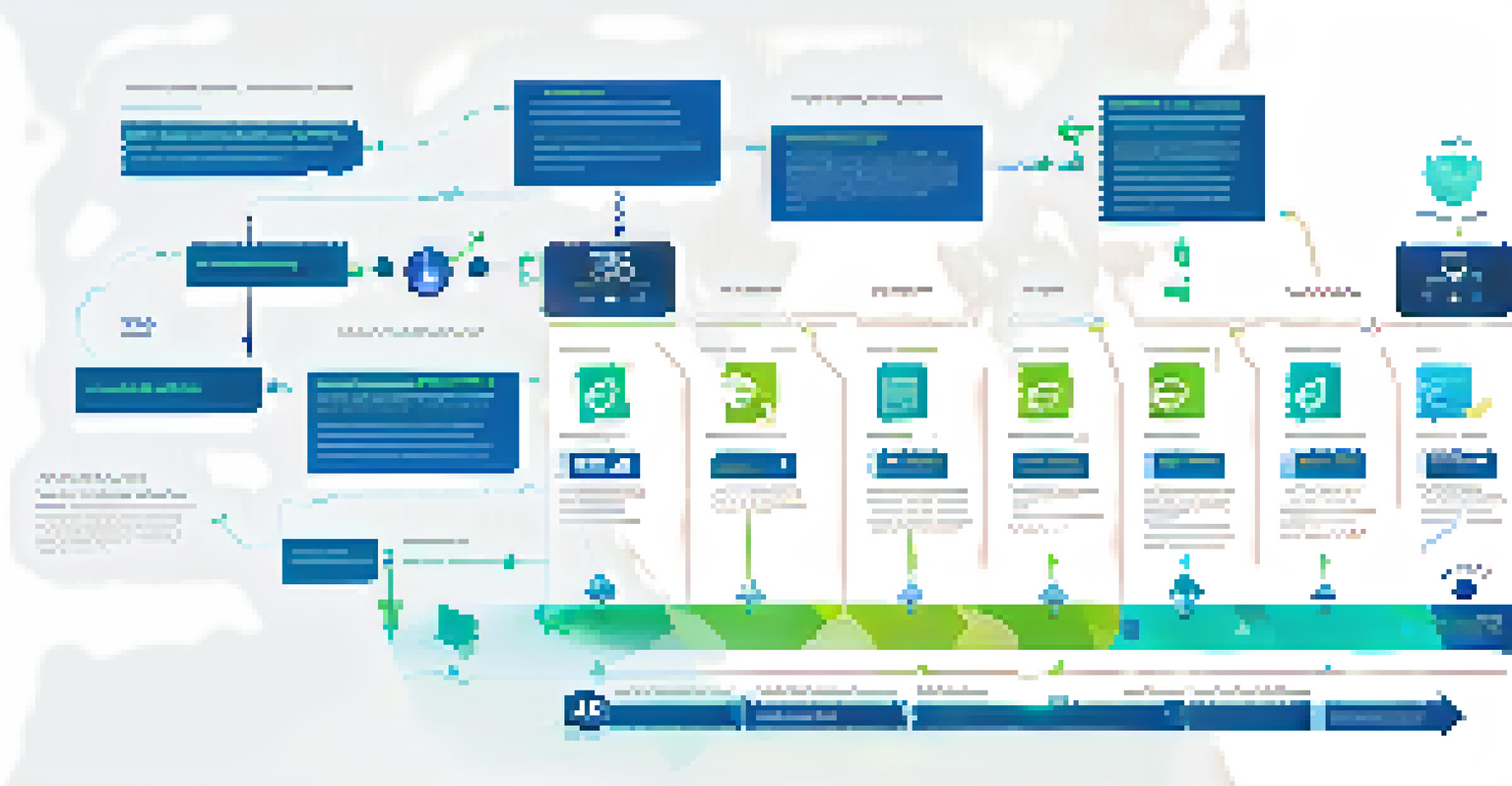The Evolution of Cross-Chain Communication with Ethereum's Help

Understanding Cross-Chain Communication in Blockchain
Cross-chain communication refers to the ability of different blockchain networks to interact and exchange data seamlessly. Think of it as a bridge that connects two islands, allowing resources and information to flow freely between them. This capability is vital for enhancing interoperability, which is increasingly important as more blockchains emerge with unique features and functionalities.
Interoperability between blockchains is the key to unlocking the full potential of decentralized applications.
The need for cross-chain communication stems from the limitations of individual blockchains, which often operate in silos. Without the ability to communicate, these networks miss opportunities for collaboration and growth. By enabling cross-chain interactions, developers can create more robust applications that benefit from the strengths of multiple blockchains.
Ethereum has been at the forefront of this evolution, providing a foundation that supports various protocols aimed at facilitating cross-chain communication. Its smart contract functionality allows developers to create complex agreements that can execute automatically when certain conditions are met, making interoperability not just a possibility, but a reality.
The Role of Ethereum in Cross-Chain Development
Ethereum's smart contracts have laid the groundwork for numerous projects focused on cross-chain communication. By utilizing Ethereum's well-established infrastructure, developers can build solutions that link disparate blockchain networks. This has led to the emergence of various cross-chain protocols that enhance the functionality of Ethereum itself and other blockchains.

For example, projects like Polkadot and Cosmos leverage Ethereum's concepts to create environments where different blockchains can communicate effectively. These platforms prioritize scalability and security, enabling developers to create applications that can operate across multiple chains. This not only enhances user experience but also maximizes resource utilization.
Cross-Chain Communication Explained
Cross-chain communication enables different blockchain networks to interact and exchange data, enhancing interoperability.
Moreover, Ethereum's extensive community and developer support have propelled these initiatives forward. By fostering an environment where innovation thrives, Ethereum continues to be a key player in shaping the future of cross-chain communication.
Notable Cross-Chain Protocols Leveraging Ethereum
Several cross-chain protocols have emerged, leveraging Ethereum's capabilities to enhance interoperability. One prominent example is the Wrapped Bitcoin (WBTC), which allows Bitcoin holders to use their assets within the Ethereum ecosystem. By wrapping Bitcoin in an ERC-20 token, users can seamlessly trade and interact with decentralized applications (dApps) on Ethereum.
The future of finance will be built on a foundation of cross-chain communication, allowing seamless transactions across multiple networks.
Another noteworthy protocol is the Inter-Blockchain Communication (IBC) protocol, which facilitates secure communication between chains within the Cosmos ecosystem. This protocol draws inspiration from Ethereum's design principles, demonstrating how Ethereum's influence extends beyond its own network. Such innovations benefit the entire blockchain space by promoting collaboration and shared functionality.
These examples illustrate how Ethereum's foundational technology has inspired diverse projects aimed at enhancing cross-chain communication. As these protocols mature, they will likely play a crucial role in the future of blockchain interoperability.
Challenges in Cross-Chain Communication
Despite its potential, cross-chain communication faces several challenges that must be addressed for widespread adoption. One major issue is the lack of standardization among different blockchain protocols, which can lead to compatibility problems. Without common frameworks, developers may struggle to create solutions that work effectively across various platforms.
Security is another significant concern, as cross-chain transactions often involve multiple parties and protocols. Ensuring that these transactions are safe from vulnerabilities is crucial, as any breach can have cascading effects across interconnected networks. This is where Ethereum's robust security features provide a valuable advantage, but they need to be extended to broader cross-chain interactions.
Ethereum's Key Role in Interoperability
Ethereum's smart contracts and extensive developer support have been instrumental in the development of cross-chain solutions.
Moreover, the complexity of managing data across different blockchains can hinder usability for developers and end-users alike. The need for user-friendly interfaces and streamlined processes is paramount for encouraging adoption. As the ecosystem evolves, addressing these challenges will be essential to fully realize the benefits of cross-chain communication.
The Future of Cross-Chain Communication
Looking ahead, the future of cross-chain communication appears promising, particularly with Ethereum's continuous evolution. As the Ethereum network transitions to Ethereum 2.0, improvements in scalability and efficiency will likely bolster cross-chain capabilities. These enhancements will make it easier for developers to create solutions that connect various blockchain networks seamlessly.
The rise of Layer 2 solutions also holds significant potential for cross-chain communication. By allowing transactions to occur off the main Ethereum chain, these solutions can alleviate congestion and reduce costs. This could create an environment where cross-chain interactions are not only feasible but also efficient and affordable for users.
As more projects prioritize interoperability, we can expect a surge in cross-chain applications that leverage Ethereum's strengths. This shift will ultimately lead to a more interconnected blockchain ecosystem, where users can enjoy the benefits of multiple networks without the barriers that currently exist.
Case Studies: Successful Cross-Chain Implementations
Several successful implementations of cross-chain communication have emerged, showcasing the effectiveness of Ethereum's infrastructure. One prime example is the integration of Aave, a decentralized lending protocol, which now allows users to borrow and lend assets across multiple blockchains. This cross-chain functionality has significantly expanded Aave's user base and enhanced liquidity.
Another case study involves Chainlink, a decentralized oracle network that connects smart contracts with real-world data. By bridging different blockchain environments, Chainlink enables developers to create applications that rely on external data sources, thereby enhancing the utility of their dApps. This interoperability not only increases the value of Chainlink but also drives innovation across the blockchain landscape.
Challenges and Future Prospects
Despite existing challenges, advancements like Ethereum 2.0 and Layer 2 solutions promise a more interconnected blockchain ecosystem.
These case studies demonstrate that cross-chain communication is not just a theoretical concept; it is actively being implemented to solve real-world problems. As more projects adopt these strategies, we can expect to see even more examples of successful cross-chain collaboration.
Conclusion: Embracing the Cross-Chain Future
In conclusion, the evolution of cross-chain communication, significantly influenced by Ethereum, marks a pivotal moment in the blockchain space. As the demand for interoperability grows, Ethereum continues to provide a robust platform for innovative cross-chain solutions. The combination of Ethereum's smart contracts, developer support, and the rise of successful protocols indicates a bright future for cross-chain communication.
While challenges remain, the ongoing development of technologies and standards will pave the way for a more interconnected ecosystem. By embracing these advancements, developers and users alike can unlock the full potential of blockchain technology, transcending the limitations of isolated networks.

As we move forward, it's clear that Ethereum's role in shaping the future of cross-chain communication will remain vital. With a collaborative approach, the blockchain community can create a seamless experience for users, allowing them to navigate across chains with ease and confidence.